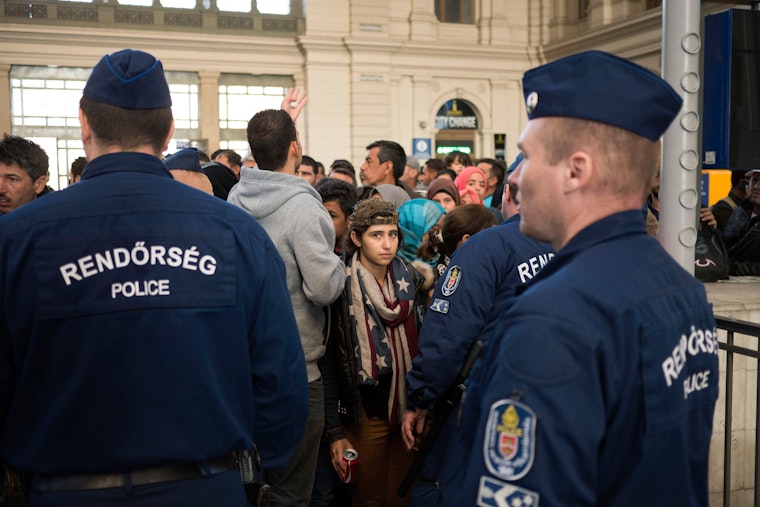What You Need to Know About the Refugee Crisis in Hungary
By Márta Pardavi & Gábor Gyulai

The inflammatory way that officials and the national media in Hungary describe the current influx of refugees creates confusion, hostility, and fear among our citizenry. This discourse has only exacerbated the xenophobia deeply entrenched in a part of the Hungarian population, and made the efforts of ordinary citizens and organizations working with asylum seekers and migrants more difficult.
The situation changes day by day—we have seen people concentrated at Budapest’s train stations, the construction of a 175-km-long border fence, violence erupting at the borders with Serbia, and new legislation [PDF] essentially preventing refugees from having access to international protection in Hungary.
The Central European nation of 10 million, recently converted into one of the main entry points to the EU for asylum seekers, undoubtedly faces a serious challenge. Here are 10 points that we should keep in mind as we work to understand what is happening in Hungary right now.
1. There is no migration crisis in Hungary.
Only one-and-a-half percent of the country’s population are immigrants—one of the lowest rates in the European Union. Most come from neighboring countries and are, on average, highly educated, gainfully employed taxpayers who contribute significantly to Hungary’s economy. In material terms, few countries have such a positive experience of immigration.
2. Migration fills in the gaps left by native-born Hungarians.
For instance, Hungary’s fertility rates have been decreasing since the 1980s, and are now among the lowest in the European Union. About 300,000 often highly qualified Hungarians have moved to other EU countries for work, leaving a labor force vacuum in medical care, IT, engineering, tourism, and other sectors.
3. These people are refugees in the purest legal sense.
In the last few months, over 80 percent of asylum seekers reaching Hungary have escaped the worst crises in the world: Syria, Afghanistan, and Iraq. The remaining 20 percent come from countries like Pakistan, Somalia, Eritrea, and Iran—countries with weak human rights records and a high level of violence. Despite government communications labelling them as economic migrants, Syrians, Iraqis, Afghans, Somalis, and other refugees have the right to asylum, and Hungary has the legal obligation to provide protection.
4. Hungary’s asylum system has already been among the strictest and fastest ones in Europe.
In 2014, Hungary granted asylum to only 9 percent of applicants when over 40 percent came from conflict zones such as Syria and Afghanistan. This is the lowest rate across the entire EU, which approves an average of 45 percent of asylum applications.
Hungary is one of the very few EU countries to detain first-time asylum seekers in large numbers. And even the open reception centers that hold asylum seekers are overcrowded, lack basic support services, and have hygienic conditions that are often unacceptable.
5. The number of migrants seeking asylum in Hungary has exponentially increased.
The number has increased from around 4,000 in 2012 to over 170,000 by September this year. The number of asylum seekers was already rising in 2013, but no provisions were taken to increase the capacity of the system despite the assistance offered from both civil society and the EU.
6. This may be a novel challenge, but it’s not the unbearable crisis many portray it as.
The vast majority of asylum seekers leave Hungary very quickly towards the West. It is estimated that half of them do not stay more in the country than one or two days, and the onward movement has further accelerated in recent months. During the summer, there were usually no more than a few thousand asylum seekers actually staying in the country. Now this number is a few hundred.
7. Hungary has recently amended its asylum legislation with the sole intention of keeping people seeking international protection out of Hungary.
The construction of a fence on the Serbian–Hungarian border was a first step explicitly aimed at blocking refugee flows (followed by a similar fence on parts of the border with Croatia and Romania being built at the moment). Changes in legislation have created a legal barrier that causes nearly all asylum claims to be automatically rejected in an extremely accelerated procedure.
Our team has witnessed how some potentially legitimate asylum claims were rejected in less than an hour in a so-called border procedure. The crossing of the border fence has been made a criminal offense, with over 250 “perpetrators” already condemned in less than two weeks, in extremely fast criminal procedures, lacking some of the most fundamental procedural safeguards [PDF]. These migrants are now expelled by the court and prohibited from entering the Schengen area for one or two years.
8. Hungary now considers Serbia a “safe third country” for refugees.
This means that it is legal to immediately send back any asylum seeker who has entered from Serbia—like Syrians, Afghans, or Iraqis—irrespective of their protection needs and the circumstances they are fleeing. This goes against EU law, the recommendation of the UN High Commissioner for Refugees, and the guidance of Hungary’s own Supreme Court. Serbia does not have a functioning asylum system and offers no shelter and no prospect of protection for most refugees.
Since mid-September, two so-called “transit zones” in Röszke and Tompa have been operating just a few meters from the border. These are now the only spots where Hungary accepts asylum applications on its border sections closed with a fence. However, at the time of writing, extremely few asylum seekers are allowed to submit an asylum claim here.
9. It’s important to recognize that the crisis in management has a European dimension.
The Common European Asylum System has not managed so far to build truly common standards, and it allows for exaggerated room for maneuver for states wishing to disregard their protection obligations. The apparent inaction of the EU and the international community against such a blatant violation of EU law and international human rights standards threatens to set a very dangerous precedent that will encourage other states to follow the same road.
10. Creating a sense of “being under attack by refugees” lays the groundwork for restricting their own citizens’ fundamental liberties.
This situation in Hungary has shown that hasty legal and practical measures—which have failed to provide protection but turn refugees away, and which are coupled with very strong rhetoric by political decision makers that question the fundamentals of asylum—will boost xenophobia and racism in the entire population.
Even when any improvement in the Hungarian asylum system seems further than ever, we see a ray of hope. We have reached a moment where Europe has recognized that there is something fundamentally problematic with its current asylum system, and willingness to step in and respond is growing.
A new responsibility-sharing mechanism based on solidarity and a higher level of cooperation is already in the making. Moreover, in order to preserve the institution of asylum and human rights protection, the EU should take bold measures to enforce its rules already in place. If it fails, the price to pay will be some of the most fundamental building blocks of the Union, such as internal free movement and the unquestionable respect for human rights and civil liberties. The negative consequences are unpredictable and reach far beyond the fate of forced migrants seeking protection.
The Hungarian Helsinki Committee is a grantee of the Open Society Foundations.
Márta Pardavi is co-chair at the Hungarian Helsinki Committee.
Gábor Gyulai is refugee program coordinator at the Hungarian Helsinki Committee.


